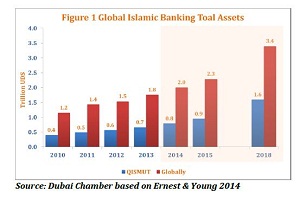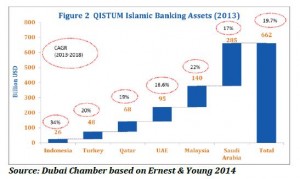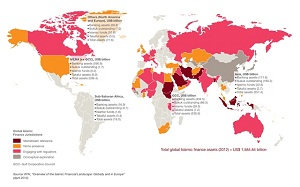- UAE’s Islamic banking assets soar to US$95 billion in 2013 compared to US$83 billion in 2012, says research note
In the framework of the preparation for the 10th World Islamic Economic Forum (WIEF), a report by the Dubai Chamber of

Commerce and Industry based on a recent study by Ernst and Young stated that global Islamic banking assets have registered cumulative annual growth rate of about 16 per cent during the period 2008-2012, reflecting the radical shift from conventional financial system in favour of Islamic finance. The 10thWIEF will be organised in Dubai by Dubai Chamber and the WIEF Foundation from 28-30 October 2014.
As the emphasis on low risk product alternatives kept the sector insulated from the financial meltdown, Islamic banking products and services have consistently gained market share in recent times, growing up to 50 per cent faster than the traditional banking sector in some markets. The UAE is emerging as a serious player in this sector with total Islamic banking assets growing to about US$95 billion in 2013 compared to US$83 billion in 2012. This momentum is unlikely to lose steam as the Dubai Chamber report shows that the compound annual growth rate (CAGR) for Islamic banking assets in the UAE is expected to be about 17 per cent over the period 2013-2018.

“The report by Dubai Chamber shows that the prospects of Islamic banking are very promising as indicated by the significantly high growth rates of Islamic banking total assets,” said H.E.HamadBuamim, President and CEO of Dubai Chamber.“The research note supports Dubai’s recognition of Islamic finance as a key pillar in the strategy to position itself as the centre for Islamic banking and finance as part of the Dubai Capital of Islamic Economy initiative,” H.E. Buamim added.
“Dubai has the potential to shape the course of the massive Islamic economy, and this is reflected in the choice of Dubai as the venue for the 10th World Islamic Economic Forum (WIEF). The Forum comes as a unique opportunityfor Dubai to give a new direction to the Islamic finance industry, and help consolidate efforts, share knowledge and experiences to leverage the emerging opportunities in the changing dynamics of the global economy,”H.E. Buamimsaid.
Dubai Chamber in its reportestimates that there are 38 million Islamic banking customers around the world with two thirds of them in Qatar, Indonesia, Saudi Arabia, Malaysia, UAE and Turkey (QISMUT).Among these six prominent Islamic finance countries, Saudi Arabia is the biggest market in terms of Islamic banking assets with estimated value of about US$285 billion in 2013 compared to US$245 billion in 2012. The research note also shows that Saudi Arabia represents about 43 per cent of the total Islamic banking assets in all the six countries. It also accounts for about 53 per cent of Saudi Arabia’s total domesticbanking assets.
According to the World Islamic Banking Competitiveness Report 2013–14, while one-fifth of the banking system assets across QISMUT have transitioned to Islamic banking, in Saudi Arabia, supply push has seen share of Islamic banking cross 50 per cent of system assets.
In 2012, the group of QISMUT was the fastest growing markets for Islamic banking, with total Islamic banking assets commanded by the QISMUT reaching about US$ 567 billion and has registered CAGR of about 16.4 per cent over the period 2008-2012, according to Dubai Chamber.
The Dubai Chamber research also shows that, globally, Islamic banking profit pool is projected to reach US$30.5 billion by 2018 driven mainly by higher retail focus. In 2012, QISMUT Islamic banking profit pool wasestimated at US$9.4 billion and it is expected to reach US$26.4 billion by 2018.

Commenting on the findings, Ashruff Jamal, PwC Global Islamic Finance Leader, said: “Dubai is powering ahead with the creation of its recently announced ‘Capital of the Islamic Economy’ initiative. A number of the building blocks of this initiative, spanning seven key pillars, are already in place as the emirate eyes the US$ 8 trillion global Islamic economy which accounts for approximately 11 per cent of Global Gross Domestic Product. This will inevitably position Dubai as the global destination of choice for Islamic products, finance and services, encourage public-private partnership in this rapidly growing sector as well as attract local and foreign investments as the emirate ramps up for Expo 2020.”
Jamal added: “A fundamental part of the global Islamic economy is the Islamic finance sector, which is witnessing rapid growth as Islamic financial institutions look to deploy their liquidity into regional and international expansion such as the acquisition of Barclay’s’ retail portfolio by Abu Dhabi Islamic Bank, and Dubai Islamic Bank’s acquisition of a 25 per cent stake in Indonesian Islamic lender Bank PaninSyariah. Another ‘first’ is the recent announcement of an Islamic Exim (export-import) bank which will be the only institution of its kind in the world with three unique features; it will be Sharia compliant, trade based and run largely by the private sector.”
Highlighting Dubai’s status as a leading financial centre for the issue of sukuk, Jamal said: “Dubai’s Islamic capital market is witnessing rapid expansion with more than US$ 16 billion of sukuks expected to be in issue by the end of this year with Dubai’s sovereign sukuks being ranked as one of the world’s best performing instruments.”
The Dubai Chamber report, however, points out that many Islamic retail banks suffer from lower profitability than the conventional banks, mainly due to higher expensesattributed to complex products, lengthy process steps and more interfaces. It is estimated that on average leading Islamic banks posted 19 per cent lower return on equity (ROE) than comparable conventional peers. The average ROE for the top 20 leading Islamic banks is about 12.6 per cent compared to an average of 15 per cent of comparable conventional banks, it states.
The Dubai Chamber research note supports recent indications that Islamic finance is extending reach, particularly in the Middle East and North Africa (MENA) region. According to Kuwait Finance House 2013 estimates, the MENA, excluding the Gulf Cooperation Council (GCC) states, remains the focal market for Islamic finance, with US$599.4 billion in total assets, followed by GCC with US$536.9 billion assets. Interestingly, Islamic finance is also gaining ground in North America and Europe with banking assets worth US$59.8 billion and total assets reaching US$71.6 billion in 2013, reflecting the industry success in transcending barriers to gain greater market share in new areas.












